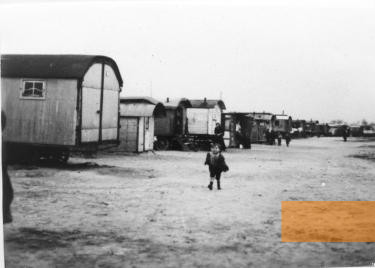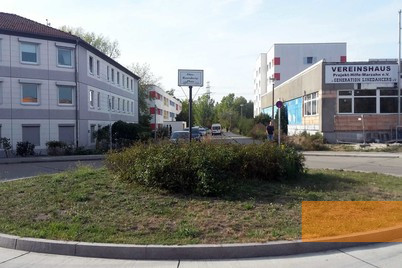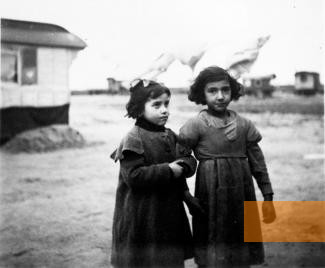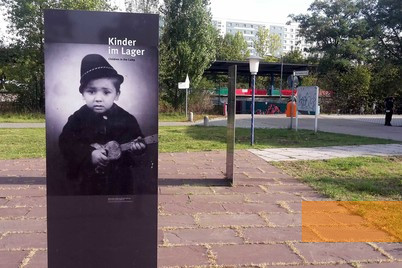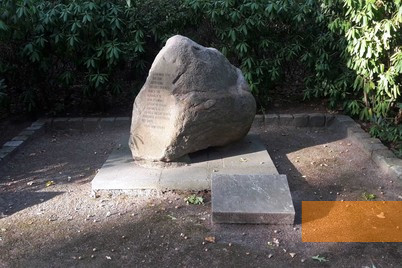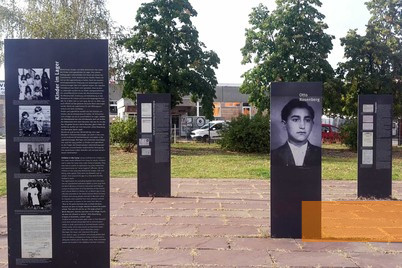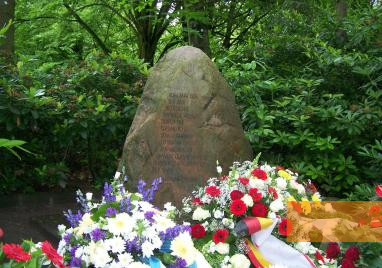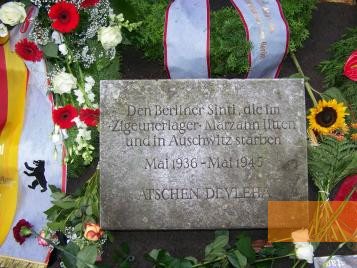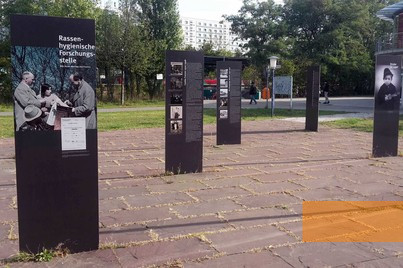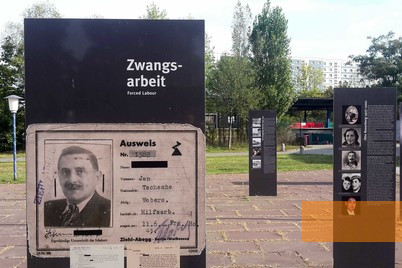The Berlin public relief office and the Berlin police set up a camp for »Gypsies« in the north-east of Berlin, in the district of Marzahn, in the spring of 1936. About 2,000 Sinti and Roma were forced to live here. In March 1943, almost all of the camp inmates were deported to Auschwitz-Birkenau and eventually murdered there. A memorial has honoured the victims of the camp since 1986.
The National Socialist authorities wished for the Reich capital to be »free of Gypsies« for the upcoming 1936 Olympic Games. Beginning May 1936, the Berlin police, together with the NSDAP's office of racial politics and the Berlin public relief office, arrested about 600 Sinti and Roma and brought them to the so-called Marzahn parking place. They were forced to live in caravans or temporary barracks. The living conditions at this camp were particularly harsh: the caravans were much to small to house families, and there were too few water supply points and toilets on the premises. By September 1938, the number of inmates at Marzahn had risen to approximately 850, many of whom fell ill due to the insufficient living conditions. Some of the men were subjected to forced labour, and no one was allowed to leave the camp without permission. Many unemployed men were later deported to the Buchenwald and Sachsenhausen concentration camps to be deployed in forced labour. From 1936 on, staff of the Research Centre for Racial Hygiene led by Robert Ritter came to the Marzahn camp in order to »research« the »Gypsy race«. In 1938, »Reichsführer-SS« Heinrich Himmler decreed that »Gypsies« were henceforth to be persecuted as a »race«. On December 16, 1942, Himmler ordered the deportation of »Gypsies« to the Auschwitz-Birkenau death camp. The first Sinti and Roma families were deported from Marzahn probably in March 1943. Most of them were murdered in Auschwitz.
It is estimated that between 1,000 and over 1,200 Sinti and Roma were incarcerated at the Marzahn camp between 1936 and 1943. Some of the men had to perform forced labour; in 1938, unemployed men were deported to the Buchenwald and Sachsenhausen concentration camps. From then on, most of the prisoners at the Marzahn camp were women and children. In 1943, almost all of the Sinti and Roma - with the exception of about 24 - were deported to Auschwitz and murdered there. How many survived remains unclear.
After most of the barracks had been destroyed in an air raid in 1944, the approximately 24 Sinti and Roma remaining there had to live together in one single barrack. At the end of April 1945, the Red Army liberated the Marzahn camp, yet the Sinti and Roma were forced to remain there for several more years, until they were allocated new living quarters.
The former camp premises were forgotten for many years; at the end of the 1970s, the East German authorities erected vast housing estates in the district of Marzahn. It was the author and environmental activist Reimar Gilsenbach (1925-2002) who prevented the history of the camp from falling into oblivion. Gilsenbach also advocated honouring Sinti and Roma as victims of National Socialism in the GDR. In 1984, he unsuccessfully attempted to gather support from the »Committee of Anti-Fascist Resistance Fighters« to establish a memorial to the Sinti and Roma. In 1985, Gilsenbach directly turned to the chairman of the Council of State, Erich Honecker. The Central Committee of the ruling communist party decided to erect a monument at the cemetery in Marzahn in 1986, close to the former camp premises. On June 29, 1986, the protestant church for the first time organised a commemorative ceremony to the Sinti and Roma at the cemetery. On September 12, 1986, the monument was dedicated in form of a memorial stone. It bears the following inscription: »From May 1936 until the liberation of our people by the glorious Soviet Army, hundreds of Sinti suffered in a camp not far from this site. Honour to the vitims.« In 1990, a further memorial plaque was added, the following year an information board presenting information about the Marzahn camp was set up.
The historic site of the camp, what is today Otto-Rosenberg-Platz, is marked by a signboard. Since 2011, there is a Memorial and Information Site initiated by the Berlin Association of German Sinti and Roma. The open air exhibition informs about the history of the camp, while biographies of individual victims are its focus.
The former camp premises were forgotten for many years; at the end of the 1970s, the East German authorities erected vast housing estates in the district of Marzahn. It was the author and environmental activist Reimar Gilsenbach (1925-2002) who prevented the history of the camp from falling into oblivion. Gilsenbach also advocated honouring Sinti and Roma as victims of National Socialism in the GDR. In 1984, he unsuccessfully attempted to gather support from the »Committee of Anti-Fascist Resistance Fighters« to establish a memorial to the Sinti and Roma. In 1985, Gilsenbach directly turned to the chairman of the Council of State, Erich Honecker. The Central Committee of the ruling communist party decided to erect a monument at the cemetery in Marzahn in 1986, close to the former camp premises. On June 29, 1986, the protestant church for the first time organised a commemorative ceremony to the Sinti and Roma at the cemetery. On September 12, 1986, the monument was dedicated in form of a memorial stone. It bears the following inscription: »From May 1936 until the liberation of our people by the glorious Soviet Army, hundreds of Sinti suffered in a camp not far from this site. Honour to the vitims.« In 1990, a further memorial plaque was added, the following year an information board presenting information about the Marzahn camp was set up.
The historic site of the camp, what is today Otto-Rosenberg-Platz, is marked by a signboard. Since 2011, there is a Memorial and Information Site initiated by the Berlin Association of German Sinti and Roma. The open air exhibition informs about the history of the camp, while biographies of individual victims are its focus.
- Name
- Ort der Erinnerung und Information für die Opfer des »Zigeunerlagers« Marzahn
- Address
-
Wiesenburger Weg 10
12681 Berlin - Phone
- +49 (0)30 435 511 70
- Fax
- +49 (0)30 435 511 72
- Web
- http://www.sinti-roma-berlin.de
- info@sinti-roma-berlin.de
- Open
- The cemetery is accessible from morning until nightfall. The exhibition is accessible at all times.
- Possibilities
- Guided tours and workshops on demand.


